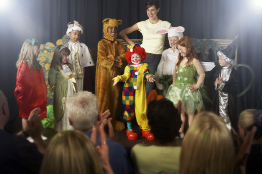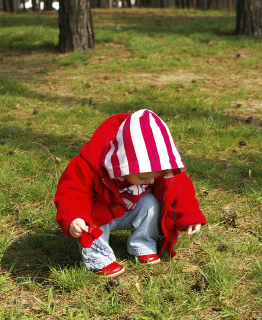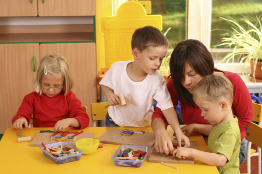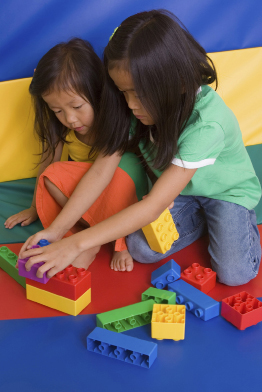Session 2
| Site: | MoodleHUB.ca 🍁 |
| Course: | CCS3120 |
| Book: | Session 2 |
| Printed by: | Guest user |
| Date: | Friday, 5 December 2025, 3:36 PM |
Description
Created by IMSreader
1. Session 2
Session 2: Intellectual Development
Introduction

Richard Lewisohn/Digital Vision/Thinkstock
Children develop intellectually by watching performances, such as plays.
Have you ever wondered why babies put toys in their mouths? Do you think that you are encouraging learning when you and a toddler watch an ant cross the sidewalk? Have you wondered what a child might learn from playing in a sandbox? When children attempt to make sense of their world, they are developing intellectually.
Session 2 focuses on children’s intellectual development. Just as child care providers focus on motor skills to promote children’s physical development, child care providers focus on thinking skills to promote children’s intellectual development.
During this session you will have opportunities to explore ways that child care providers can support children’s thinking. You will also learn how to enrich the child care environment to promote learning.

© Tatyana Ogryzko/iStockphoto
Getting Focused Activity: A Child’s Mind
Focus
Sometimes people are so busy telling children what to do, or trying to teach them something, that they miss wonderful opportunities to encourage children to develop their minds! The following poem gives insight into how you can better appreciate the minds of children.
Directions
Step 1: Read the poem “Child’s Mind” slowly and dramatically.
Step 2: Complete Getting Focused Activity: A Child’s Mind.
Checking In
Save your completed learning activity in the appropriate sub-folder of your course folder.
1.1. Inquiry 1
Session 2: Intellectual Development
Inquiry 1: Intellectual Development and Piaget’s Theory
To provide you with an overview of the intellectual development of children between the ages of birth to six years, watch the video “Cognitive Development.”
Course Project
The video includes a lot of information about promoting children’s intellectual development. Look at the items and strategies you have made so far for your strategies box. Do any of these items and strategies also promote intellectual development?
Applying Piaget’s Theory
environment: all the different conditions and influences that affect the development of a child after birth
learning: a general term used to describe changes to someone’s behaviour because of what has been experienced
Consider the following information about intellectual development:
- Children’s experiences in the first six years of life have lifelong effects on intellectual ability.
- Every child has a different potential for intellectual ability.
- The ability of the child to reach his or her potential will depend on how the environment fosters and promotes intellectual development.
- Children’s intellect develops in predictable stages.
- Children progress through the stages at their own rates.
- Children view the world differently than adults as they progress through various stages of intellectual development.
- Every child has a preferred learning style.
Stages of Intellectual Development
Much of today’s understanding of intellectual development comes from the theories of Jean Piaget. While some of Piaget’s theories have been challenged or modified, the importance of his work in the area of early childhood intellectual development carries on. Two main lessons can be learned from the theories of Jean Piaget:
- Babies and young children think differently than adults and older children.
- You can encourage intellectual development, but you can’t “push” a child to think beyond the level of her or his development.
According to Piaget’s theory, children are in various stages at certain years of age.

© Clint Scholz/iStockphoto
Sensory Motor Stage
In the first two years of life, babies display the following intellectual development:
- Babies explore the immediate environment with their senses. They do not understand what is part of their body and what is part of the world around them. For example, babies of this age may hit their noses with their hands, but they will not understand that their hands are part of their bodies.
- Babies then begin to understand the difference between objects and their actions upon those objects. For example, babies in this stage might hit an object by accident, see it move, understand the connection, and then hit the object again to make it move.
- In the first year of life, babies don’t fully understand that an object exists when they cannot see the object.
Pre-Operational Stage

© Monika Adamczyk/iStockphoto
Between the ages of two and seven years, children display the following intellectual development:
- They understand that objects are permanent, and they begin to use language to label these concepts. They are now able to realize that a toy still exists even if they can’t see the toy.
- Toddlers have difficulty understanding other people’s perspectives. They think that everyone perceives the world as they do. This phase is referred to as egocentrism. This does not mean that they are selfish but, rather, that they are not able to understand the perspectives of others.
egocentrism: the inability to understand the perspectives of others
- As toddlers develop, they begin to learn to classify objects (e.g., the round ones and the blue ones), and they begin to form concepts (e.g., all big things are heavy).
- Children before the age of six can generally only reason in a simple, step-by-step way. They cannot reason “backward” or discover faults in reasoning.
- Children before the age of six generally believe what they see; they find it difficult to reason abstractly.
Why Is it Important to Understand Piaget’s Theory?
Piaget’s theory made the following clear:
- Preschool children need to learn by doing: interacting with the environment and touching, seeing, smelling, tasting, and hearing.
- Preschool children are not developmentally ready to understand another child’s point of view or the abstract value of sharing.
- Children need to be provided with many opportunities to learn through experimenting and playing with objects, but they cannot be forced to understand concepts before they are ready.
Course Completion Checklist
Have you remembered to update your Course Completion Checklist? If you haven’t already started to use the checklist, access it in the Toolkit now. Remember to update the Course Completion Checklist every time you work on the course.
1.2. Learning Activity 1
Session 2: Intellectual Development
Learning Activity 1: Learning Styles
Focus
Children, like adults, have preferred learning styles. Discovering your preferred learning style will help you learn about and understand different learning styles.
Directions
Step 1: There are all kinds of learning style quizzes. Ask your teacher to provide you with a learning style quiz or search for one on the Internet.
If you are doing an Internet search, try the search terms “Canada learning styles + career quizzes Canada.” This should take you into the Training and Careers section of the Service Canada website. Choose one of the many quizzes available on the website.
Step 2: Complete the learning style quiz that you obtained in Step 1.
Checking In
Contact your teacher for instructions on whether or not to save your completed quiz in your course folder.
1.3. Inquiry 2
Session 2: Intellectual Development
Inquiry 2: Understanding Why Learning Styles Matter

© ktaylorg/iStockphoto
Learning Styles
People learn in different ways. Some learn best by seeing, others by hearing, and others by touching. Knowing our learning styles helps us learn and remember new things. Knowing children’s learning styles helps us better respond to their needs.
- The main learning styles are
– auditory (hearing the information)
– visual (seeing the information)
– kinesthetic-tactile (touching, manipulating, and exploring)
- Children learn most easily in their preferred learning style.
- Children need a lot of experience to use and improve all styles of learning.
- Young children are all kinesthetic-tactile learners.
- Attention to learning styles when children are young will help make learning positive and enjoyable.
Learning Style Checklist
|
Visual learners often . . . |
Auditory learners often . . . |
Kinesthetic-tactile learners |
|
enjoy oral discussions
|
prefer activities
|
People often have varying degrees of preference for different learning styles—some people are highly auditory (they learn through hearing the information), some are highly visual (they learn through seeing the information), while others are highly kinesthetic-tactile (they learn through touching, participating, and physical involvement).
Most young children have a preference for kinesthetic-tactile learning. Babies put everything in their mouths, and toddlers reach out to touch and explore their worlds. Visual and auditory preferences may emerge later. It is important for child care providers to ensure children have many opportunities to use all of the learning styles, so that children can develop to their fullest potentials. It is also important that child care providers know the learning styles of the children with whom they work. Then the providers can help the children learn more effectively.
While people learn more easily using their preferred learning style, this does not mean they can’t and won’t learn in any other way. In fact, people (including children) should be encouraged to use and improve all ways of learning—the more senses used, the more information understood. A good guideline is to allow children to use their preferred style when learning essential information (e.g., road safety) and to practise using other learning styles for areas that are not as critical (e.g., words to a song).
Regardless of preferred learning style, most of us learn better if we are actively involved in our own learning.
Important: Because each person tends to teach in her or his preferred learning style, it is important for you, as a child care provider, to know your own preferred learning style. When you are aware of your own learning style, you are more likely to pay attention to a variety of styles.
It can be frustrating for both a child and the child care provider if the two have different learning styles and the child care provider only designs activities that match the provider’s preferred style. For example, imagine how frustrating it would be for all if a child care provider who is a strong auditory learner were to verbally explain the rules of baseball to a child whose preferred learning style is visual.
Checking My Understanding
Learning Styles
Directions
For each activity in this “Learning Styles” drag-and-drop activity, you will determine whether Marci, a child care provider, is engaging the children in an activity most suited for auditory, visual, or kinesthetic-tactile learners.
1.4. Learning Activity 2
Session 2: Intellectual Development
Learning Activity 2: Many Ways Children Learn
Focus
When the day in a child care centre is organized so that children are engaged in different activities, the children will have opportunities to learn in many ways.
Important: Remember that children explore more when they feel secure. If the environment in a child care facility is set up to reflect the cultural diversity of the children in the program, then the children will likely feel secure and will explore their environment.
Directions
Step 1: Go to a child care facility and complete Learning Activity 2: Many Ways Children Learn.
Step 2: After completing Step 1, discuss what you observed with another student in your class. Be sure to talk about your examples and the learning styles that are being promoted in your examples.
Checking In
Save your completed learning activity in the appropriate sub-folder of your course folder. You will complete a rubric on this activity as part of Learning Activity 3.
1.5. Inquiry 3
Session 2: Intellectual Development
Inquiry 3: Developmental Milestones from Birth to Five Years
The table “Intellectual Development Milestones” illustrates how children progress through the stages of intellectual development. It is important to remember that each child is unique and develops at his or her own rate.
The Role of the Child Care Provider in Supporting Children’s Intellectual Development

iStockphoto/Thinkstock
Child care providers can support children’s intellectual development in many ways. Programs that best meet children’s emotional and physical needs better prepare children to learn from the world around them. Child care providers need to make sure children have enough time, space, materials, and support to actively explore and develop intellectually. Practising the following guidelines will help:
- Provide a stimulating environment that is safe both physically and emotionally. This environment includes a variety of materials that are appropriate to the children’s developmental levels.
- Encourage children to satisfy their natural curiosity. When it is safe, encourage children to do the following:
– look
– touch
– taste
– smell
– listen
– experiment
– create
– ask and answer questions
– solve problems
– sort
– classify (group similar objects together)
– find similarities and differences
- Provide long unstructured play times so children can become actively involved in learning through play.
- Ask open-ended questions to encourage children to explore and to solve problems.
- Observe verbal and non-verbal clues given by the child as the child plays (e.g., “What is this?” or “Is this smiling or yawning?”). These clues help child care providers to respond appropriately and to plan additional experiences.
- Take advantage of unplanned moments to encourage children to explore and learn (e.g., by taking children to the window to watch the snow fall).
- Model and, therefore, create excitement for discovering and learning.
- Accept each child’s learning style and abilities as unique.
- Recognize that intellectual learning is related to learning in all areas.
- Ensure the children’s environment is representative of all the children (e.g., abilities, ethnicity, family structure, and so on).
1.6. Learning Activity 3
Session 2: Intellectual Development
Learning Activity 3: Children Learn as They Explore
Focus
When child care providers take time to analyze how the environment can encourage children’s intellectual development, they are better able to create environments in which children have lots of opportunities to learn.
Directions
Step 1: Review Exploring Environment: A Way to Learn.
Step 2: Complete Part 1 of Learning Activity 3: Children Learn as They Explore.
Step 3: If you have never read Bartholomew and the Oobleck, by Dr. Seuss, obtain a copy of the book and read the story, or read an overview of the story on the Internet.
Step 4: Do an Internet search using the terms “oobleck + Dr. Seuss + science experiment.” Find a recipe for making Dr. Seuss’ Oobleck, otherwise known as goop.
Important: There are lots of recipes for goop. It doesn’t matter whether you use a recipe based on cornstarch, a recipe based on white glue and borax, or some other recipe. You might even decide to try several recipes.
Step 5: Gather the ingredients, find an area in which you can get messy, and make goop.
Step 6: As you interact with the goop, imagine activities you could do with the goop with children in a child care centre, and then consider how these activities could promote children’s intellectual development.
Important: In Step 6, think about how you might incorporate Dr. Seuss’ story into your goop activities. Don’t forget to think about how the book could also be incorporated into activities.
Step 7: Discuss Step 6 with a partner. Together, complete Part 2 of the activity sheet you already started, Children Learn as They Explore.
Step 8: Review the Student Rubric for Learning Activity 2: Many Ways Children Learn and for Learning Activity 3: Children Learn as They Explore. Assess your work from both activities together and make any necessary adjustments.
Checking In
Save your completed learning activity and your self-assessment in the appropriate sub-folder of your course folder.
1.7. Learning Activity 4
Session 2: Intellectual Development
Learning Activity 4: How Children Play with Materials
Focus
Children at different stages of intellectual development will use toys and materials differently. Having an understanding of developmental stages will help caregivers plan activities and choose appropriate materials.
Children begin to play with toys by looking at them, putting them in their mouths, and batting at them. In six short years, children develop a variety of complex ways of playing with materials and toys. This is the result of changes in their intellectual development.
Directions
Step 1: Complete Learning Activity 4: How Children Play with Materials.
Step 2: Review the Student Rubric for Learning Activity 4: How Children Play with Materials. Assess the quality of your work and make any necessary adjustments.
Step 3: Complete the Reflections section on the Student Rubric.
Checking In
Save your completed learning activity and your self-assessment in the appropriate sub-folder of your course folder.
Course Project
Could you develop any of the items or ideas you suggested in Learning Activity 4 to be included in your strategies box? Now is a good time to work on your strategies box.
1.8. Session 2 Summary
Session 2: Intellectual Development
Session Summary
Important: The quiz may contain questions beyond points highlighted in this summary. Be sure to review the session thoroughly.
Review Session 2 to prepare for writing the quiz. As you review, note the sections that connect with the following points:
- All children have a potential for learning.
- Children use their senses for learning.
- Intellectual development is closely related to all other areas of development.
- Children go through a series of stages as they move toward adult-like thinking.
- The caregiver strongly influences the learning environment.
- Caregivers provide a stimulating environment that is safe both physically and emotionally. The environment includes a variety of materials that are appropriate to the children’s developmental levels.
- Caregivers model an excitement for discovering and learning.
- Caregivers ensure that the environment is culturally diverse and reflects the abilities of the children it represents.
- Caregivers recognize that each child is an individual with varying abilities, leaning styles, and interests.
Session Quiz
Checking In
Contact your teacher to decide together when and where you will complete the Session 2 Quiz.
Course Project
Have you kept up with adding items and strategies to your strategies box? Now is a good time to check how your strategies box is coming along. Since you have finished two of the three sessions, you should have developed approximately two-thirds of your items and strategies.